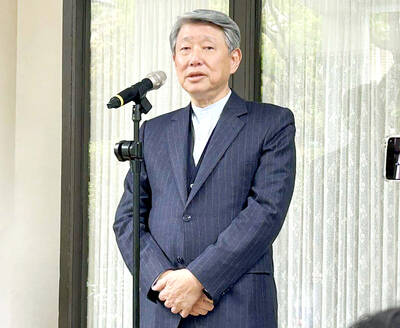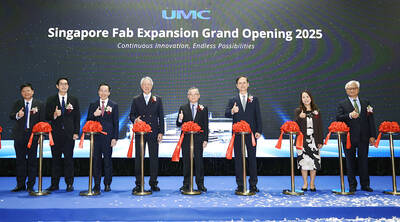Company representatives from around the world will be able to put their hands on ultra-thin laptops running on Microsoft Corp’s highly anticipated new operating system at Computex Taipei next month, one of the organizers said.
This year at Computex, visitors will see a preview of Windows 8-based Ultrabooks, said Enoch Du (杜全昌), secretary-general of the Taipei Computer Association (TCA, 台北市電腦公會), which co-organizes the world’s second-largest tech trade fair.
“Although Microsoft is very cautious about the launch, vendors in fact are ready to offer the Windows 8 devices, including Ultrabooks, tablet computers and smart handheld devices,” he said in an interview recently.
“You can put your hands on the models and use them,” Du added. “With the release of the Windows 8, there will be a big jump in Ultrabook [sales] volumes.”
In the fourth quarter of last year, the world’s top five PC vendors all introduced Ultrabook-type products, but their price tags exceeded US$1,000, making them less attractive, according to DRAMexchange Technology Inc (集邦科技).
The average notebook price is about US$650 this year, so Ultrabook prices need to dip below US$700 to be acceptable to consumers, the research firm said.
Factoring in the expected price cut, Ultrabook shipments are forecast at 20 million units this year, accounting for 10 percent of total notebook shipments, compared with 2 percent last year, it predicted.
Meanwhile, the PC industry chain will see a big change in business models, such as the integration of mobile chipsets designed by ARM Holdings PLC, which are widely used in Android-based smartphones and tablet PCs to lower power consumption, Du said.
Intel Corp, which supplies processors for Ultrabooks, has forecast that the category might be priced as low as US$599 in the second half of this year, when manufacturers use new and cheaper casing materials, such as a mixture of plastics and aluminum.
The US chipmaker projected that the new models to be launched in the third and fourth quarter would support new functions, such as touch-enabled screens and gesture sensors, which would help drive overall demand.
For this year as a whole, Intel expected Ultrabooks to account for between 30 and 40 percent of global notebook shipments, thanks to the introduction of lower-priced models.
However, Du said that 20 percent would be a more reasonable penetration rate this year, because Intel’s forecast looks more like a long-term target.
“The pricing for Ultrabooks is related to the total volume,” he said. “When the volume increases, component costs drop and then lower the retail prices, driving a virtuous cycle.”
“I’m optimistic that Ultrabooks will become cheaper and cheaper, but it will be quite difficult to see US$599 models this year,” Du said.
Last month, Asustek Computer Inc (華碩) said Ultrabooks would gain more momentum in the second half of this year thanks to an increase in the supply of new chipsets and the expected launch of the new Windows system.
Asustek plans to roll out a number of new Ultrabooks priced from US$799 to US$1,999 starting in the current quarter, and the company expects the category to account for between 10 and 20 percent of its notebook shipments this year.
Separately, Acer Inc (宏碁) has reduced its Ultrabook prices to as low as US$799 in selected regions, but the price has remained too high for many consumers, compared with a price tag of between US$400 and US$500 for mainstream notebooks.
Acer projected that Ultrabooks will account for between 12 and 20 percent of its notebook shipments by the end of this year, which would be lower than the 25 to 35 percent that the company forecast earlier, because of less promotion by the industry.
Computex Taipei, to be held from June 5 to June 9, is expected to attract more than 36,000 international buyers and generate US$28 billion in business, up from US$25 billion last year, the organizers estimated.

MULTIFACETED: A task force has analyzed possible scenarios and created responses to assist domestic industries in dealing with US tariffs, the economics minister said The Executive Yuan is tomorrow to announce countermeasures to US President Donald Trump’s planned reciprocal tariffs, although the details of the plan would not be made public until Monday next week, Minister of Economic Affairs J.W. Kuo (郭智輝) said yesterday. The Cabinet established an economic and trade task force in November last year to deal with US trade and tariff related issues, Kuo told reporters outside the legislature in Taipei. The task force has been analyzing and evaluating all kinds of scenarios to identify suitable responses and determine how best to assist domestic industries in managing the effects of Trump’s tariffs, he

TIGHT-LIPPED: UMC said it had no merger plans at the moment, after Nikkei Asia reported that the firm and GlobalFoundries were considering restarting merger talks United Microelectronics Corp (UMC, 聯電), the world’s No. 4 contract chipmaker, yesterday launched a new US$5 billion 12-inch chip factory in Singapore as part of its latest effort to diversify its manufacturing footprint amid growing geopolitical risks. The new factory, adjacent to UMC’s existing Singapore fab in the Pasir Res Wafer Fab Park, is scheduled to enter volume production next year, utilizing mature 22-nanometer and 28-nanometer process technologies, UMC said in a statement. The company plans to invest US$5 billion during the first phase of the new fab, which would have an installed capacity of 30,000 12-inch wafers per month, it said. The

Taiwan’s official purchasing managers’ index (PMI) last month rose 0.2 percentage points to 54.2, in a second consecutive month of expansion, thanks to front-loading demand intended to avoid potential US tariff hikes, the Chung-Hua Institution for Economic Research (CIER, 中華經濟研究院) said yesterday. While short-term demand appeared robust, uncertainties rose due to US President Donald Trump’s unpredictable trade policy, CIER president Lien Hsien-ming (連賢明) told a news conference in Taipei. Taiwan’s economy this year would be characterized by high-level fluctuations and the volatility would be wilder than most expect, Lien said Demand for electronics, particularly semiconductors, continues to benefit from US technology giants’ effort

‘SWASTICAR’: Tesla CEO Elon Musk’s close association with Donald Trump has prompted opponents to brand him a ‘Nazi’ and resulted in a dramatic drop in sales Demonstrators descended on Tesla Inc dealerships across the US, and in Europe and Canada on Saturday to protest company chief Elon Musk, who has amassed extraordinary power as a top adviser to US President Donald Trump. Waving signs with messages such as “Musk is stealing our money” and “Reclaim our country,” the protests largely took place peacefully following fiery episodes of vandalism on Tesla vehicles, dealerships and other facilities in recent weeks that US officials have denounced as terrorism. Hundreds rallied on Saturday outside the Tesla dealership in Manhattan. Some blasted Musk, the world’s richest man, while others demanded the shuttering of his